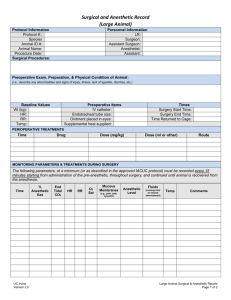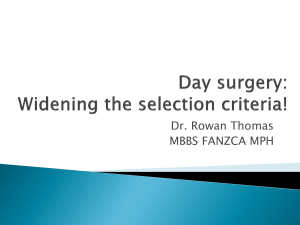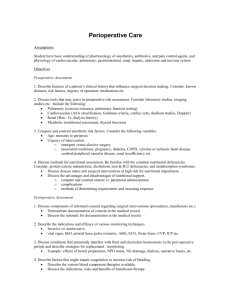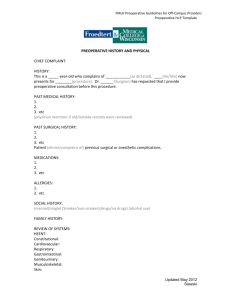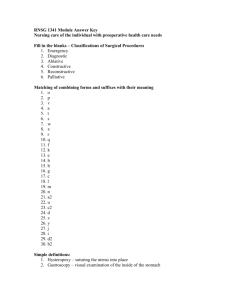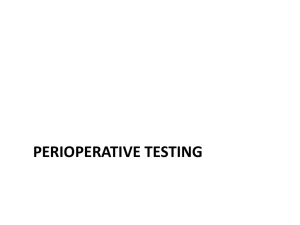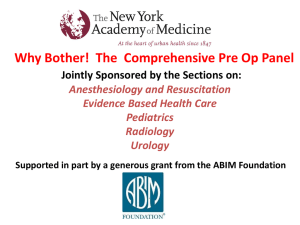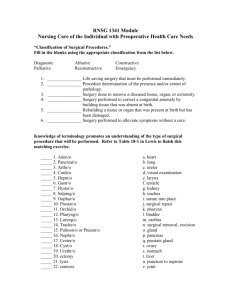Preoperative Evaluation
advertisement
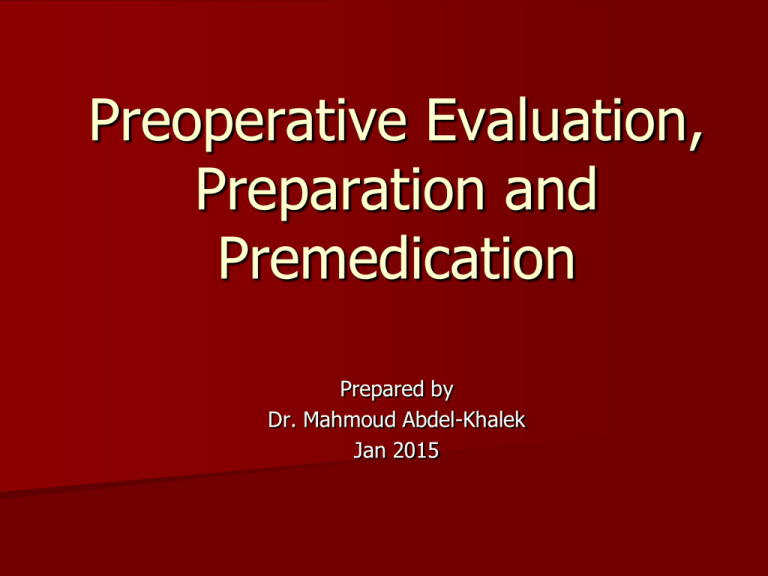
Preoperative Evaluation, Preparation and Premedication Prepared by Dr. Mahmoud Abdel-Khalek Jan 2015 Preoperative Evaluation Anesthetic drugs and techniques have profound effects on human physiology. Hence, a focused review of all major organ systems should be completed prior to surgery. Goals of the preoperative evaluation is to ensure that the patient is in the best (or optimal) condition. Patients with unstable symptoms should be postponed for optimization prior to elective surgery. Steps of the preoperative visit : I. Problem Identification II. Risk Assessment III. Preoperative Preparation IV. Plan of Anesthetic Technique I. Problem Identification Through : ●History (including a review of the patient's chart) ●Physical examination ●laboratory investigation Problem Identification Cont’d • Cardiovascular : • Respiratory : • Neuromuscular : • Endocrlne : • GI - Hepatic : hypertension ; ischemic , valvular or congenital heart disease; CHF or cardiomyopathy, , arrhythmias smoking; COPD; restrictive lung disease; altered control of breathing (obstructive sleep apnea, CNS disorders, etc.) raised ICP ; TIA's or CVA's; seizures; spinal cord Injury; disorders of NM junction e.g myasthenia gravis, muscular dystrophies ,MH steroid therapy DM; thyroid disease; pheochromocytoma; hepatic disease; gastresophageal reflux Problem Identification Cont’d • Renal : • Hematologic : • Elderly , Children, Pregnancy • Medications and Allergies • Prior Anesthetics • Related to Surgery : renal failure anemias; coagulopathies significant blood loss; respiratory compromise; positioning Physical Examination: General & Local examination Should focus on evaluation of : • Upper airway • Respiratory system • Cardiovascular system • other systems’ problems identified from the history Preoperative Laboratory Testing: only if indicated from the preoperative history and physical examination. "Routine or standing" pre operative tests should be discouraged -CBC anticipated significant blood loss, suspected hematological disorder (eg.anemia, thalassemia, SCD), or recent chemotherapy. -Electrolytes diuretics, chemotherapy, renal or adrenal disorders -ECG age >50 yrs ,history of cardiac disease, hypertension, peripheral vascular disease, DM, renal, thyroid or metabolic disease. -Chest X-rays prior cardiothoracic procedures ,COPD, asthma, a change in respiratory symptoms in the past six months. -Urine analysis DM, renal disease or recent UTI. -tests for different systems according to history and examination II. Risk Assessment Components for evaluating perioperative risk: 1. Preoperative patient's medical condition 2. Extent of the surgical procedure 3. Risk from the anesthetic ASA Physical Status Classification System medical status mortality ASA I normal healthy patient without organic, biochemical, or psychiatric disease 0.06-0.08% ASA II mild systemic disease with no significant impact on daily activity e.g. mild diabetes, controlled hypertension, obesity . Unlikely to have an impact 0.27-0.4% ASA III severe systemic disease that limits activity e.g. angina, COPD, prior myocardial infarction Probable impact 1.8-4.3% ASA IV an incapacitating disease that is a constant threat to life e.g. CHF, unstable angina, renal failure ,acute MI, respiratory failure requiring mechanical ventilation Major impact 7.8-23% ASA V moribund patient not expected to survive 24 hours e.g. ruptured aneurysm 9.4-51% ASA VI brain-dead patient whose organs are being harvested For emergent operations, you have to add the letter ‘E’ after the classification. Surgical Risk Low Risk Procedures Low surgical risk: – – – – – – Endoscopy Bronchoscopy Cystoscopy Dermatologic procedures Breast biopsy Opthalmologic procedures Surgical Risk Intermediate surgical risk: – – – – Orthopedic surgery Urologic surgery Uncomplicated abdominal surgery Uncomplicated head and neck Surgical Risk High surgical risk: – – – – Emergency surgery Cardiac procedures Aortic or vascular surgery Anticipated prolonged surgery Large fluid shifts or blood loss Ex: Whipple, spinal surgery III. Preoperative Preparation • Anesthetic indications: -Anxiolysis, sedation and amnesia. e.g. benzodiazepine(diazepam ,lorazepam) -Analgesia e.g narcotics -Drying of airway secretions e.g atropine,glycopyrrolate,scopolamine -Reduction of anesthetic requirements ,Facilitation of smooth induction -Patients at risk for GE reflux :ranitidine ,metoclopramide , sodium citrate • Surgical indications: -Antibiotic prophylaxis for infective endocarditis. -Prophylaxis against DVT for high risk patients : low-dose heparin or aspirin intermittent calf compression, or warfarin. • Co-existing Disease indications: Some medications should be continued on the day of surgery e,g B blockers, thyroxine. Others are stopped e.g oral hypoglycemics and antidepressants . Steroids within the last six months may require supplemental steroids Fasting Recommendations Ingested material Minimum fasting period (hr) Clear liquids 2 Breast milk 4 Infant formula 6 Nonhuman milk 6 Light meal (toast and clear liquids) 6 IV. Plan of Anesthetic Technique 1. Is the patient's condition optimal? 2. Are there any problems which require consultation or special tests? “Please assess and advise “ 3. Is there an alternative procedure which may be more appropriate? 4. What are the plans for postoperative management of the patient? 5. What premedication if any is appropriate? Finally, we plan our anesthetic technique : 1. Local or Regional anesthesia 2. General anesthesia; with or without intubation. Spontaneous or controlled ventilation is used. 3. Combined regional with general anesthesia.

